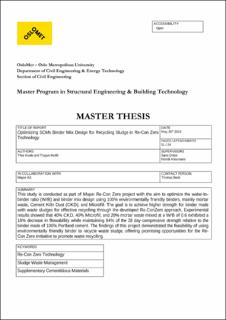| dc.description.abstract | Concrete ready mix plant manufacturers face the dual challenges of managing returned concrete and the water required for cleaning the delivery track, as well as the disposal of waste generated during the washing process. To overcome those challenges, Mapei AS has developed an environmentally friendly and innovative solution known as Re-Con Zero (RCZ). This technology consists of using a two-component powder additive to dry-clean concrete trucks and recycle the returned concrete into aggregates that could be used to replace natural aggregates in the production of concrete. Upon the successful implementation of this approach, Mapei is eager now to extend the application of RCZ to other type of waste, including waste sludge. Transforming this waste into aggregates was hindered by their non-hydraulic nature. The aggregates made of sludge failed to dry or gain strength over time. To solve this issue, this study aims to suggest an optimized binder mix design that facilitates recycling of waste sludge by RCZ.
Considering the environmental challenges associated with cement production, this work proposed the use of 100% waste materials, such as mortar waste, Cement Kiln Dust (CKD), and microfil. The effectiveness of the binders was evaluated based on their impact on the flowability, hardened density and the compressive strength development over time. A total of 15 mixes, varying in binders’ content and water to binder ratio (W/B) were investigated to determine the optimal mix design combination for recycling sludge by RCZ.
Experimental results showed that the increase in CKD content and a decrease in microfil content in the mixtures resulted in a diminished performance. Furthermore, a high W/B ratio, above 1.0, resulted in a watery mixture with negligible strength. The most optimal mixture consisted of 40% CKD, 40% microfil, and 20% mortar waste, with a W/B ratio of 0.6. This mixture exhibited 16% lower flowability compared to the reference sample made of 100% Portland cement, but still achieved 84% of the 28 day-compressive strength of the reference sample. The reduced flowability reflects the ability of this binder to dry faster, which is crucial for the production of aggregates with RCZ.
The improvement of sludge properties by the incorporation of the suggested alternative binder expands the possibilities of using RCZ for recycling other wastes. | en_US |
